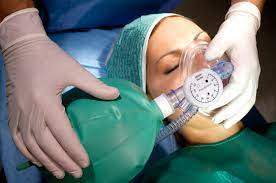Definisi
Syok adalah suatu kondisi gawat darurat yang terjadi ketika tubuh tidak mendapatkan aliran darah yang cukup. Kurangnya aliran darah akan menyebabkan sel dan organ tidak mendapatkan cukup oksigen dan nutrisi untuk berfungsi dengan baik. Sebagai akibatnya, banyak organ tubuh yang dapat mengalami kerusakan. Syok dapat disebabkan oleh cedera atau kondisi apa pun yang memengaruhi aliran darah ke seluruh tubuh Anda.
Syok merupakan kondisi yang dapat memburuk dengan cepat, menyebabkan beberapa kegagalan organ, serta berpotensi menimbulkan komplikasi yang mengancam jiwa. Diperkirakan sebanyak 1 dari 5 orang yang mengalami syok akan meninggal. Maka dari itu, diperlukan pertolongan segera dalam tata laksana kasus syok.
Penyebab
Terdapat beberapa jenis syok yang dibagi berdasarkan penyebab timbulnya syok, antara lain:
1. Syok Septik
Syok ini timbul sebagai akibat dari perkembang-biakan bakteri dalam darah dan racun yang dilepaskan bakteri-bakteri tersebut. Penyebab umum dari syok jenis ini adalah:
-
- Pneumonia (infeksi pada paru-paru)
- Infeksi saluran kemih
- Infeksi kulit (selulitis)
- Infeksi organ dalam tubuh (seperti usus buntu yang pecah)
- Meningitis (infeksi pada selaput otak)
2. Syok Neurogenik
Syok neurogenik merupakan jenis syok yang disebabkan oleh cedera pada tulang belakang, biasanya akibat suatu kecelakaan.
3. Syok Anafilaktik
Syok anafilaktik timbul sebagai akibat dari reaksi alergi yang berat dan berlebihan. Penyebabnya antara lain alergi terhadap sengatan serangga, obat-obatan, atau makanan (kacang-kacangan, buah beri, makanan laut), dll.
4. Syok Kardiogenik
Jenis syok ini biasanya timbul ketika jantung mengalami kerusakan dan tidak mampu memompa pasokan darah yang cukup ke seluruh tubuh. Kondisi ini bisa menjadi tahap akhir dari kasus serangan jantung atau gagal jantung kongestif.
5. Syok Hipovolemik
Syok hipovolemik disebabkan oleh kehilangan darah dan cairan dalam jumlah yang banyak, seperti dari cedera tubuh, yang membuat jantung tidak dapat memompa cukup darah ke tubuh, atau anemia berat di mana tidak ada cukup darah untuk membawa oksigen ke seluruh tubuh.
Syok itu sendiri disebabkan oleh berkurangnya aliran darah ke jaringan dan organ tubuh. Keadaan ini dapat disebabkan oleh beberapa kondisi, antara lain:
- Kegagalan distribusi oksigen ke sel-sel tubuh, misalnya ketika:
- Jumlah oksigen di udara yang dihirup berkurang
- Berada di daerah ketinggian
- Keracunan karbon monoksida, dll.
- Gangguan pada paru sehingga organ paru tidak dapat menyalurkan oksigen ke aliran darah. Contoh penyebabnya antara lain:
- Pneumonia (infeksi pada paru-paru)
- Gagal jantung kongestif (paru-paru terisi dengan cairan atau edema paru)
- Cedera yang mengakibatkan paru-paru menjadi memar atau mengempis
- Emboli paru (penyumbatan pada pembuluh darah di paru-paru)
- Jantung yang tidak dapat memompa darah secara memadai ke jaringan tubuh. Contoh penyebabnya antara lain:
- Serangan jantung sehingga otot jantung rusak dan jantung tidak bisa berdetak dengan kuat untuk memompa darah ke seluruh tubuh
- Adanya gangguan irama jantung
- Peradangan pada kantung di sekitar jantung (perikarditis) atau radang pada otot jantung karena infeksi atau penyebab lain, sehingga kemampuan jantung untuk memompa darah menjadi tidak efektif
- Kurangnya sel darah merah dalam darah (anemia). Jika tidak terdapat cukup sel darah merah, maka oksigen yang dikirim ke jaringan tubuh juga akan berkurang. Kondisi ini mungkin disebabkan oleh:
- Perdarahan
- Ketidakmampuan sumsum tulang untuk membuat sel darah merah
- Peningkatan penghancuran sel darah merah oleh tubuh (misalnya, penyakit sel sabit)
- Kurangnya cairan di dalam pembuluh darah, misalnya pada kasus:
- Dehidrasi akibat kehilangan cairan tubuh
- Gangguan pada sistem saraf pusat sehingga pembuluh darah tidak dapat mempertahankan tekanan yang cukup di dalam dindingnya untuk memungkinkan darah dipompa ke seluruh tubuh
Faktor Risiko
Risiko terjadinya syok akan meningkat jika Anda memiliki beberapa kondisi seperti:
- Reaksi alergi berat
- Kehilangan darah dalam jumlah banyak
- Infeksi dalam darah
- Dehidrasi
- Keracunan
- Luka bakar
- Gangguan jantung
- Cedera pada tulang belakang
- Muntah atau diare terus-menerus
Gejala
Pada orang-orang yang mengalami syok akan ditemukan salah satu atau beberapa gejala berikut, yaitu:
- Denyut nadi yang cepat, lemah, atau bahkan tidak ada denyut nadi
- Detak jantung yang tidak teratur
- Nyeri dada
- Suhu tubuh tidak berada dalam rentang yang normal
- Pernapasan yang cepat, pendek, dan dangkal
- Pusing
- Kulit yang dingin
- Bibir dan kuku kebiruan
- Keringat berlebihan
- Mual
- Kebingungan
- Kecemasan
- Haus dan mulut kering
- Pupil mata melebar
- Penurunan jumlah urine
- Gula darah rendah
- Penurunan kesadaran
- Tekanan darah yang rendah
- Kejang
Diagnosis
Syok termasuk suatu kasus gawat darurat sehingga perlu didiagnosis secara cepat agar bisa segera ditata laksana. Biasanya, dokter dapat dengan mudah mengenali syok dari gejala-gejala yang tampak pada penderita. Dokter juga dapat memeriksa bagaimana tekanan darah, denyut nadi, pernapasan, dan suhu pasien. Dokter akan bertanya juga mengenai riwayat penyakit pasien dan apa yang terjadi sebelum pasien jatuh ke dalam kondisi syok.
Setelah diagnosis syok ditegakkan, prioritas pertama dokter adalah memberikan perawatan untuk menyelamatkan nyawa agar darah dapat beredar ke seluruh tubuh secepat mungkin. Hal ini dapat dilakukan dengan memberikan cairan, obat-obatan, komponen darah, dan perawatan suportif lainnya.
Keadaan syok tidak akan sembuh kecuali dokter dapat menemukan dan mengobati penyebabnya. Setelah kondisi penderita stabil, dokter akan mencoba mencari penyebab terjadinya syok. Untuk melakukannya, dokter dapat menyarankan satu atau lebih pemeriksaan, seperti:
1. Tes Pencitraan
Dokter mungkin melakukan tes pencitraan untuk memeriksa adakah cedera atau kerusakan pada jaringan dan organ internal Anda, seperti patah tulang, pecahnya organ dalam tubuh, robekan pada otot atau tendon, serta pertumbuhan jaringan abnormal dalam tubuh. Tes pencitraan dapat meliputi:
- USG
- Sinar-X
- CT-scan
- MRI
2. Tes Darah
Dokter mungkin menggunakan tes darah untuk mencari tanda-tanda:
- Kehilangan darah yang signifikan
- Infeksi dalam darah Anda
- Penggunaan obat tertentu atau overdosis obat
Tata Laksana
Tata laksana syok perlu dilakukan sesegera mungkin untuk mencegah timbulnya komplikasi yang mengancam nyawa. Seseorang yang mengalami kondisi syok harus dibawa ke instalasi gawat darurat (IGD) dan mendapat penanganan medis. Karena syok bisa terjadi akibat beragam penyebab, tata laksana yang diberikan juga tergantung dengan penyebab syok.
Bila pasien mengalami syok akibat perdarahan dan kehilangan darah dalam jumlah banyak, sebagai pertolongan pertama Anda bisa menekan bagian tubuh yang berdarah dengan menggunakan handuk atau kain sembari membawa pasien ke IGD. Bila pasien kehilangan cairan akibat muntah berulang atau keluar darah dari mulut, bila hal ini terjadi bukan akibat kecelakaan atau tidak terdapat kecurigaan adanya cedera tulang belakang, Anda bisa memiringkan pasien untuk mencegah tersedak. Muntahan atau darah yang dikeluarkan bisa masuk ke dalam saluran napas pasien dan hal ini bisa memperburuk kondisi pasien. Anda bisa membuka atau mengendurkan pakaian yang ketat dan bila perlu, tutupi penderita dengan selimut untuk mencegah kedinginan. Namun, jika Anda menemukan seseorang mengalami syok dan mulai tidak menunjukkan tanda-tanda kehidupan, seperti tidak bernapas, tidak sadar, tidak teraba nadi, atau tidak bergerak, Anda bisa melakukan RJP (Resusitasi Jantung Paru).
Setelah bantuan medis tiba, dokter biasanya akan memberikan terapi awal, seperti:
- Pemberian cairan melalui infus
- Menjaga suhu tubuh pasien tetap stabil
- Pemberian obat-obatan untuk menaikkan tekanan darah dan denyut nadi
- Pemberian oksigen
- Pemasangan alat bantu napas jika diperlukan
- Pemberian obat antibiotik pada syok septik untuk mengatasi infeksi yang terjadi
Komplikasi
Jika tidak ditangani dengan cepat dan tepat, syok dapat menimbulkan beberapa komplikasi, seperti kegagalan beberapa fungsi organ tubuh, kecacatan, dan bahkan kematian.
Pencegahan
Beberapa jenis dan kasus syok dapat dicegah. Lakukan langkah-langkah berikut untuk menjalani gaya hidup yang sehat, seperti:
- Jika Anda telah didiagnosis dengan alergi, hindari faktor pemicunya, dan bawa obat anti alergi yang diresepkan dokter, dan gunakan pada saat tanda pertama reaksi alergi muncul. Bila alergi tidak membaik setelah pemberian obat Anda bisa segera ke IGD untuk mendapatkan penanganan lebih lanjut.
- Untuk menurunkan risiko kehilangan darah akibat cedera, selalu gunakan alat pelindung diri saat melakukan aktivitas fisik, seperti mengendarai sepeda, dan menggunakan peralatan/mesin berbahaya. Selalu gunakan sabuk pengaman saat bepergian dengan kendaraan bermotor.
- Untuk menurunkan kemungkinan kerusakan jantung, konsumsi makanan yang seimbang, olahraga teratur, dan hindari merokok dan perokok pasif.
- Tetap terhidrasi dengan minum banyak cairan. Hal ini sangat penting ketika Anda menghabiskan waktu di lingkungan yang sangat panas atau lembab.
Kapan Harus ke Dokter?
Segera kunjungi IGD jika Anda atau kerabat Anda memiliki faktor risiko seperti alergi, dan mengalami gejala-gejala syok untuk mendapatkan pengobatan yang tepat. Syok merupakan kondisi gawat darurat yang memerlukan penanganan segera.
Mau tahu informasi seputar penyakit lainnya? Cek di sini, ya!
- dr Hanifa Rahma
Brouhard, R. What is Shock?. (2022). Accessed April 14, 2022, from https://www.verywellhealth.com/types-of-shock-4018329
Cunha, JP. Shock: 5 Types, Treatment, Symptoms & 8 Main Causes. (2022). Accessed April 14, 2022, from https://www.medicinenet.com/shock/article.htm
Heller, JL. Shock. (2019). Accessed April 14, 2022, from https://medlineplus.gov/ency/article/000039.htm
Kahn, A. What You Should Know About Shock. (2019). ]Accessed April 14, 2022, from https://www.healthline.com/health/shock#prevention
Shock: First Aid. (2019). Accessed April 14, 2022, from https://www.mayoclinic.org/first-aid/first-aid-shock/basics/art-20056620
Wedro, B. Shock. Accessed April 14, 2022, from https://www.emedicinehealth.com/shock/article_em.htm












